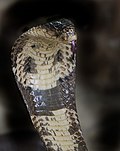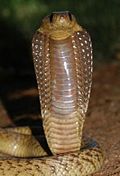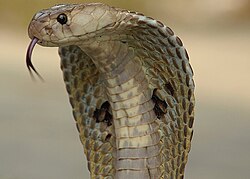| Image [5] | Species [5] | Authority [5] | Subsp.* [5] | Common name | Geographic range |
|---|
| N. anchietae | Bocage, 1879 | 0 | Anchieta's cobra (Angolan Cobra) | Angola, Botswana, Namibia, Zambia, eastern Zimbabwe |
 | N. annulata | Buchholz & W. Peters, 1876 | 1 | Banded water cobra | Cameroon, the Central African Republic, the Democratic Republic of the Congo (Zaire), the Republic of Congo, Equatorial Guinea, Gabon, Rwanda, and the province of Cabinda in Angola |
 | N. annulifera | W. Peters, 1854 | 0 | Snouted cobra | Botswana, Malawi, Mozambique, South Africa, Swaziland, Zambia, Zimbabwe |
| † N. antiqua | Rage, 1976 | 0 | | Miocene-aged strata of Morocco |
| N. arabica | Scortecci, 1932 | 0 | Arabian cobra | Oman, Saudi Arabia, Yemen |
| N. ashei | Wüster & Broadley, 2007 | 0 | Ashe's spitting cobra (giant spitting cobra) | southern Ethiopia, Kenya, Somalia, eastern Uganda |
 | N. atra | Cantor, 1842 | 0 | Chinese cobra | southern China, northern Laos, Taiwan, northern Vietnam |
| N. christyi | (Boulenger, 1904) | 0 | Congo water cobra | the Democratic Republic of the Congo (Zaire), the Republic of Congo, and the province of Cabinda in Angola |
| N. fuxi | Shi, G. Vogel, Chen & Ding, 2022 | 0 | Brown banded cobra | China, Myanmar, Laos, Thailand, Vietnam |
| N. guineensis | Broadley, Trape, Chirio, Ineich & Wüster, 2018 | 0 | Black forest cobra | Ghana, Guinea, Guinea-Bissau, the Ivory Coast, Liberia, Sierra Leone, Togo |
 | N. haje | Linnaeus, 1758 | 0 | Egyptian cobra | Tanzania, Kenya, Somalia, Ethiopia, Uganda, South Sudan, Sudan, Cameroon, Nigeria, Niger, Burkina Faso, Mali, Senegal, Mauritania, Morocco, Algeria, Tunisia, Libya, and Egypt |
| † N. iberica | Szyndlar, 1985 | | | Miocene-aged strata of Spain |
 | N. kaouthia | Lesson, 1831 | 0 | Monocled cobra | Bangladesh, Bhutan, Burma, Cambodia, southern China, eastern India, Laos, northwestern Malaysia, Nepal, Thailand, southeastern Tibet, Vietnam |
 | N. katiensis | Angel, 1922 | 0 | Mali cobra (Katian spitting cobra) | Benin, Burkina Faso, Cameroon, Ghana, Guinea, the Ivory Coast, Mali, Gambia, Mauritania, Niger, Nigeria, Senegal, Togo |
 | N. mandalayensis | Slowinski & Wüster, 2000 | 0 | Mandalay spitting cobra (Burmese spitting cobra) | Myanmar (Burma) |
 | N. melanoleuca | Hallowell, 1857 | 0 | Central African forest cobra | Angola, Benin, Cameroon, the Central African Republic, the Republic of Congo, the Democratic Republic of the Congo (Zaire), Equatorial Guinea, Gabon, Nigeria |
 | N. mossambica | W. Peters, 1854 | 0 | Mozambique spitting cobra | extreme southeastern Angola, Botswana, Malawi, Mozambique, Somalia, northeastern Namibia, South Africa, Swaziland, Tanzania (including Pemba Island), Zambia, Zimbabwe |
| N. multifasciata | (F. Werner, 1902) | 0 | Many-banded cobra | Cameroon, Congo, the Democratic Republic of the Congo (Zaire), Gabon |
 | N. naja | (Linnaeus, 1758) | 0 | Indian cobra (spectacled cobra) | Bangladesh, Bhutan, India, Nepal, Pakistan, Sri Lanka |
 | N. nana | Collet & Trape, 2020 | 0 | Dwarf water cobra | Democratic Republic of Congo |
 | N. nigricincta | Bogert, 1940 | 1 | Zebra spitting cobra | Angola, Namibia, South Africa |
 | N. nigricollis | Reinhardt, 1843 | 0 | Black-necked spitting cobra | Angola, Benin, Burkina Faso, Burundi, Cameroon, the Central African Republic, Chad, the Democratic Republic of the Congo (Zaire) (except in the central region), Congo, Ethiopia, Gabon, Gambia, Ghana, Guinea-Bissau, Guinea, the Ivory Coast, Kenya, Liberia, Mali, Mauritania, Namibia, Niger, Nigeria, Rwanda, Senegal, Sierra Leone, Sudan, Tanzania, Somalia, Togo, Uganda, Zambia |
 | N. nivea | (Linnaeus, 1758) | 0 | Cape cobra (yellow cobra) | Botswana, Lesotho, Namibia, South Africa |
 | N. nubiae | Wüster & Broadley, 2003 | 0 | Nubian spitting cobra | Chad, Egypt, Eritrea, Niger, Sudan |
| N. obscura | Saleh & Trape, 2023 | 0 | Obscure cobra | Egypt |
 | N. oxiana | (Eichwald, 1831) | 0 | Caspian cobra | Afghanistan, northwestern India, Iran, Kyrgyzstan, Pakistan, Tajikistan, Turkmenistan, Uzbekistan |
 | N. pallida | Boulenger, 1896 | 0 | Red spitting cobra | Djibouti, Ethiopia, Kenya, Somalia, Tanzania |
| N. peroescobari | Ceríaco, Marques, Schmitz & Bauer, 2017 | 0 | São Tomé forest cobra, cobra preta | São Tomé and Príncipe (São Tomé) |
 | N. philippinensis | Taylor, 1922 | 0 | Philippine cobra | the Philippines (Luzon, Mindoro) |
| † N. romani | (Hofstetter, 1939) | 0 | † | Miocene-aged strata of France, Germany, Austria, Russia, Hungary, Greece and Ukraine. [48] |
 | N. sagittifera | Wall, 1913 | 0 | Andaman cobra | India (the Andaman Islands) |
 | N. samarensis | W. Peters, 1861 | 0 | Samar cobra | the Philippines (Mindanao, Bohol, Leyte, Samar, Camiguin) |
 | N. savannula | Broadley, Trape, Chirio & Wüster, 2018 | 0 | West African banded cobra | Benin, Burkina Faso, Cameroon, Chad, Gambia, Ghana, Guinea, the Ivory Coast, Mali, Niger, Nigeria, Senegal, Togo |
| N. senegalensis | Trape, Chirio & Wüster, 2009 | 0 | Senegalese cobra | Benin, Burkina Faso, Ghana, Guinea, Guinea-Bissau, the Ivory Coast, Mali, Niger, Nigeria, Senegal |
 | N. siamensis | Laurenti, 1768 | 0 | Indochinese spitting cobra | Cambodia, Laos, Thailand, Vietnam |
 | N. sputatrix | F. Boie, 1827 | 0 | Javan spitting cobra | Indonesia (Java, the Lesser Sunda Islands, East Timor) |
 | N. subfulva | Laurent, 1955 | 0 | Brown forest cobra | Angola, Burundi, Cameroon, the Central African Republic, Chad, the Republic of Congo, the Democratic Republic of the Congo (Zaire), Ethiopia, Kenya, Malawi, Mozambique, Nigeria, Rwanda, Somalia, South Africa, South Sudan, Tanzania, Uganda, Zambia, Zimbabwe |
 | N. sumatrana | J. Müller, 1887 | 0 | Equatorial spitting cobra | Brunei, Indonesia (Sumatra, Borneo, Bangka, Belitung), Malaysia, the Philippines (Palawan), southern Thailand, Singapore |
|



























